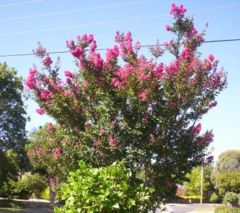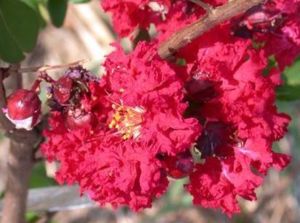Lagerstroemia indica: Difference between revisions
No edit summary |
No edit summary |
||
| Line 1: | Line 1: | ||
{{Inc| | |||
Lagerstroemia indica (L. chinensis). Crape Myrtle. Figs. 2060, 2061. Glabrous, smooth- and | |||
brown- barked shrub, with rather small (2 in. long) elliptic or oblong sessile mostly acute lvs.: | |||
panicle open, sometimes minutely pubescent; fls. usually bright pink, but there are blush, purplish | |||
and white forms; calyx not ribbed, glabrous or nearly so. Widely cult. in India, but probably native | |||
to China. —Grown everywhere in the S. Atlantic and Gulf States for its profuse summer bloom, | |||
and sometimes it has escaped. The crape myrtle is of the easiest cult. The old bushes bloom | |||
profusely, but the plant will produce fls. the first year from seed. The seeds start readily in spring if sown in boxes in autumn and are not allowed to dry out. It is also prop. readily by cuttings of ripe wood. The bloom may be increased by cutting back so that fresh growth is secured. The plant may be grown in a tub or pot in a cool greenhouse, and will bloom 2 or 3 times a year if it is cut back. It has no special soil requirements. In the N. the root may survive if it is well protected, and strong shoots will arise that give bloom the same year. Sometimes the plants are lifted in autumn, carried over winter in a cellar and planted out in spring. As the crape myrtle blooms almost continuously for a period of 2 or 3 months (beginning in June far S.), it well repays what care may be given it under glass or in regions where it is not fully hardy. | |||
}} | |||
{{Taxobox | {{Taxobox | ||
| color = lightgreen | | color = lightgreen | ||
Revision as of 22:37, 12 May 2009
| Standard Cyclopedia of Horticulture |
|---|
|
Lagerstroemia indica (L. chinensis). Crape Myrtle. Figs. 2060, 2061. Glabrous, smooth- and brown- barked shrub, with rather small (2 in. long) elliptic or oblong sessile mostly acute lvs.: panicle open, sometimes minutely pubescent; fls. usually bright pink, but there are blush, purplish and white forms; calyx not ribbed, glabrous or nearly so. Widely cult. in India, but probably native to China. —Grown everywhere in the S. Atlantic and Gulf States for its profuse summer bloom, and sometimes it has escaped. The crape myrtle is of the easiest cult. The old bushes bloom profusely, but the plant will produce fls. the first year from seed. The seeds start readily in spring if sown in boxes in autumn and are not allowed to dry out. It is also prop. readily by cuttings of ripe wood. The bloom may be increased by cutting back so that fresh growth is secured. The plant may be grown in a tub or pot in a cool greenhouse, and will bloom 2 or 3 times a year if it is cut back. It has no special soil requirements. In the N. the root may survive if it is well protected, and strong shoots will arise that give bloom the same year. Sometimes the plants are lifted in autumn, carried over winter in a cellar and planted out in spring. As the crape myrtle blooms almost continuously for a period of 2 or 3 months (beginning in June far S.), it well repays what care may be given it under glass or in regions where it is not fully hardy.
|
| Lagerstroemia indica {{{status}}} Fossil range: {{{fossil_range}}}
| ||||||||||||||||||||||||||||||||||||||||||||||||||||||||||||||||||
|---|---|---|---|---|---|---|---|---|---|---|---|---|---|---|---|---|---|---|---|---|---|---|---|---|---|---|---|---|---|---|---|---|---|---|---|---|---|---|---|---|---|---|---|---|---|---|---|---|---|---|---|---|---|---|---|---|---|---|---|---|---|---|---|---|---|---|
 | ||||||||||||||||||||||||||||||||||||||||||||||||||||||||||||||||||
| Plant Info | ||||||||||||||||||||||||||||||||||||||||||||||||||||||||||||||||||
| ||||||||||||||||||||||||||||||||||||||||||||||||||||||||||||||||||
| Scientific classification | ||||||||||||||||||||||||||||||||||||||||||||||||||||||||||||||||||
| ||||||||||||||||||||||||||||||||||||||||||||||||||||||||||||||||||
| [[{{{diversity_link}}}|Diversity]] | ||||||||||||||||||||||||||||||||||||||||||||||||||||||||||||||||||
| {{{diversity}}} | ||||||||||||||||||||||||||||||||||||||||||||||||||||||||||||||||||
| Binomial name | ||||||||||||||||||||||||||||||||||||||||||||||||||||||||||||||||||
| Lagerstroemia indica (L.) Pers. | ||||||||||||||||||||||||||||||||||||||||||||||||||||||||||||||||||
| Trinomial name | ||||||||||||||||||||||||||||||||||||||||||||||||||||||||||||||||||
| {{{trinomial}}} | ||||||||||||||||||||||||||||||||||||||||||||||||||||||||||||||||||
| Type Species | ||||||||||||||||||||||||||||||||||||||||||||||||||||||||||||||||||
| {{{type_species}}} | ||||||||||||||||||||||||||||||||||||||||||||||||||||||||||||||||||
| {{{subdivision_ranks}}} | ||||||||||||||||||||||||||||||||||||||||||||||||||||||||||||||||||
| [[Image:{{{range_map}}}|{{{range_map_width}}}|]] | ||||||||||||||||||||||||||||||||||||||||||||||||||||||||||||||||||
| Synonyms | ||||||||||||||||||||||||||||||||||||||||||||||||||||||||||||||||||
| {{{synonyms}}} |
Lagerstroemia indica (Crape myrtle, Crepe myrtle) is a species in the genus Lagerstroemia in the family Lythraceae.
From China and Japan, Lagerstroemia indica is an often multistemmed, deciduous tree with a wide spreading, flat topped, open habit when mature.
The bark is a prominent feature being smooth, pinkinsh-gray and mottled, shedding each year. Leaves are small and dark green changing to yellow and orange in autumn.
Flowers are white, pink, mauve, purple or carmine with crimped petals, in panicles up to 9cm.
Lagerstroemia indica is frost tolerant, prefers full sun and will grow to 6 metres with a spread of 6 metres.
Many hybrid cultivars have been developed between L. indica and L. faueri

References
- Flora, The Gardeners Bible, ABC Publishing, Ultimo, NSW, Australia, 2005